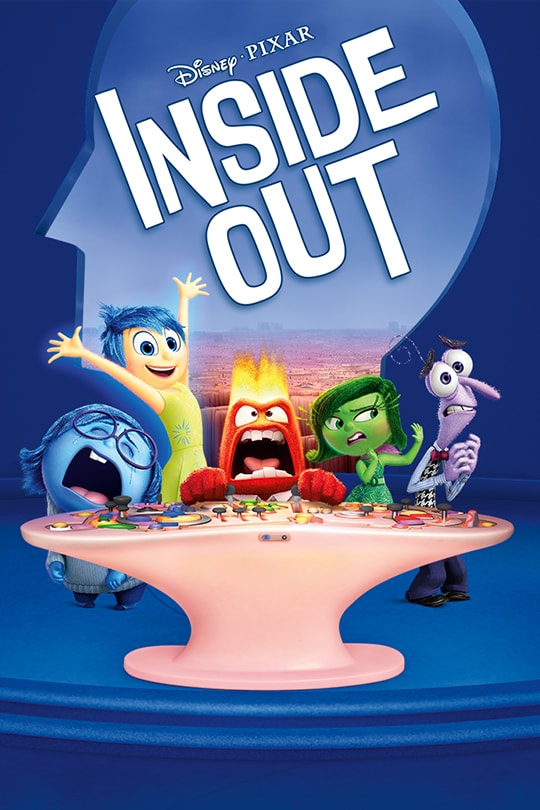

‘Do you ever look at someone and wonder what is going on inside their head?’
Pixar’s Inside Out follows the life of Riley, an 11-year-old girl. It starts off with your classic heart-warming montage of this bubbly little girl running around experiencing life, accompanied by her two loving parents. The setting of the film predominantly takes place in Riley’s head, which is run by the always cheerful Joy along with the other anthropomorphised emotions: Fear, Anger, Disgust, and Sadness. The filmmakers deserve a nod for their incredible ingenuity in creating the world inside Riley’s head, and breathing life into otherwise theoretical concepts like memory and abstract thought. For those of you who haven’t seen the film, I’m sure you’ve come across the term ‘core memory’, which also plays its own important role in the plot.
From the onset, it’s very clear that Joy runs the show as she darts back and forth across the control panel, ensuring Riley experiences and expresses as much happiness in situations as possible. Early on in the movie we see friction between Joy and Sadness. Joy is convinced that her feeling is superior and prioritises Riley experiencing positive emotions. In doing so, she gives Sadness all these unnecessary tasks to keep her occupied and away from the control panel, since she doesn’t quite understand her purpose. What initially seems like an entertaining dynamic soon unfolds into a message on toxic positivity and how it can only get us so far in terms of processing our emotions.
As the plot progresses, and Riley’s family moves from Minnesota to San Francisco, we see Joy struggle to respond to every novel adversity in Riley’s life with happiness. What this film succeeds in doing is demonstrating the impossibility of cherry picking feelings. Instead, it shows us that experiencing the entire spectrum of emotions is a fundamental part of the human condition (your feelings are valid!). From an adaptive perspective we know that feelings assign meaning to the things we encounter and experience – whether it’s fear keeping us away from danger, disgust making sure we don’t accidentally poison ourselves, or sadness showing us that we cared about something. Without leaning into each and every one of these emotions, we aren’t able to develop and learn from past experiences fully. It seems simple, but the delivery of this message is what makes Inside Out stand out in my opinion.
In general, this movie addresses a number of relatively complex psychological topics with finesse. There is one part where Riley is no longer controlled by either Joy or Sadness and we see her inability to really feel anything, similar to when individuals go into survival mode in response to emotional stress. Both the viewers and Joy learn that we also need to feel sad to assign meaning to things, including to feeling happy. Whether this was intentional or not, I couldn’t help but notice that Joy’s hair was blue, like Sadness, which felt like a nod to the film’s underlying message that the two emotions co-exist. Without giving too much away, a key point in the film is when Riley expresses true sadness in front of her parents for the first time and then apologises for it. For individuals who were generally cheerful/unproblematic/easy children, this part really hits home and once again demonstrates the absurdity of only fixating on positive emotions.
All-round creative, witty, and entertaining. Inside Out gives us an intimate portrait of growing up, coupled with a ton of symbolism, silly little nuances and gems like the line: ‘Oh no! These facts and opinions look so similar!’. While Inside Out was originally released in 2015, the messages it communicates are just as applicable today.
Directed by: Pete Docter
Inside Out is available on Disney+.

‘Do you ever look at someone and wonder what is going on inside their head?’
Pixar’s Inside Out follows the life of Riley, an 11-year-old girl. It starts off with your classic heart-warming montage of this bubbly little girl running around experiencing life, accompanied by her two loving parents. The setting of the film predominantly takes place in Riley’s head, which is run by the always cheerful Joy along with the other anthropomorphised emotions: Fear, Anger, Disgust, and Sadness. The filmmakers deserve a nod for their incredible ingenuity in creating the world inside Riley’s head, and breathing life into otherwise theoretical concepts like memory and abstract thought. For those of you who haven’t seen the film, I’m sure you’ve come across the term ‘core memory’, which also plays its own important role in the plot.
From the onset, it’s very clear that Joy runs the show as she darts back and forth across the control panel, ensuring Riley experiences and expresses as much happiness in situations as possible. Early on in the movie we see friction between Joy and Sadness. Joy is convinced that her feeling is superior and prioritises Riley experiencing positive emotions. In doing so, she gives Sadness all these unnecessary tasks to keep her occupied and away from the control panel, since she doesn’t quite understand her purpose. What initially seems like an entertaining dynamic soon unfolds into a message on toxic positivity and how it can only get us so far in terms of processing our emotions.
As the plot progresses, and Riley’s family moves from Minnesota to San Francisco, we see Joy struggle to respond to every novel adversity in Riley’s life with happiness. What this film succeeds in doing is demonstrating the impossibility of cherry picking feelings. Instead, it shows us that experiencing the entire spectrum of emotions is a fundamental part of the human condition (your feelings are valid!). From an adaptive perspective we know that feelings assign meaning to the things we encounter and experience – whether it’s fear keeping us away from danger, disgust making sure we don’t accidentally poison ourselves, or sadness showing us that we cared about something. Without leaning into each and every one of these emotions, we aren’t able to develop and learn from past experiences fully. It seems simple, but the delivery of this message is what makes Inside Out stand out in my opinion.
In general, this movie addresses a number of relatively complex psychological topics with finesse. There is one part where Riley is no longer controlled by either Joy or Sadness and we see her inability to really feel anything, similar to when individuals go into survival mode in response to emotional stress. Both the viewers and Joy learn that we also need to feel sad to assign meaning to things, including to feeling happy. Whether this was intentional or not, I couldn’t help but notice that Joy’s hair was blue, like Sadness, which felt like a nod to the film’s underlying message that the two emotions co-exist. Without giving too much away, a key point in the film is when Riley expresses true sadness in front of her parents for the first time and then apologises for it. For individuals who were generally cheerful/unproblematic/easy children, this part really hits home and once again demonstrates the absurdity of only fixating on positive emotions.
All-round creative, witty, and entertaining. Inside Out gives us an intimate portrait of growing up, coupled with a ton of symbolism, silly little nuances and gems like the line: ‘Oh no! These facts and opinions look so similar!’. While Inside Out was originally released in 2015, the messages it communicates are just as applicable today.
Directed by: Pete Docter
Inside Out is available on Disney+.



